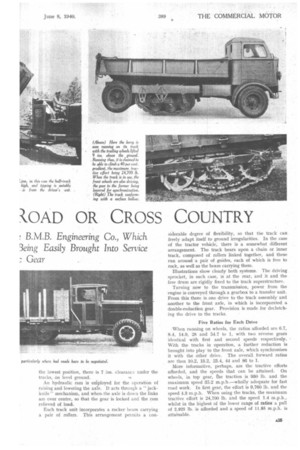AN UNUSUAL VEHICLE FC OAD OR CROSS COUNTRY
Page 26

Page 27

If you've noticed an error in this article please click here to report it so we can fix it.
The Linn, Now Being Handle, Has Both Wheels and Track, by I
B.M.B. Engineering Co., Which 3eing Easily Brought into Service
Gear
EXCESSIVE mental etfort is not required to think of numerous conditions of operation for which a vehicle, offering the characteristics of a wheeled lorry combined with those of a track-laying machine, seems to be but little short of ideal.
For transport in connection with quarrying, agriculture, building, forestry, military requirements, public works, etc., the ability to carry the load to or from the very site, however difficult the terrain, and to be able also to travel without restriction on the made-up highway is certainly valuable. Without it, transference of load from one vehicle to another, or running at a disadvantage for ffiuch of the time are the alternatives.
Track Lifted by Depressing Axle Such a machine is the Linn, a vehicle of transatlantic origin, which is now being handled in this country by the B.M.B. Engineering Co., Britannia House, Ampton Street, London, W.C.1. As can be seen from some of the accompanying pictures, the vehicle, in lorry form, has four pneumatic-tyred wheels, the rear pair of which can be raised or lowered, and track mechanism as well. In another form it is a more-or-less straightforward halftrack machine.
As the former type is the more interesting, we propose to concentrate on a description of this. Described as the new model C5, it has a pay-load capacity of 5 tons, whilst the chassis weighs practically the same figure and the body and hoist gear scale just over 1 ton. Power is provided by a Hercules six-cylindered engine, with bore and stroke of 4g ins. and 41 ins., respectively, and developing 105 b.h.p. at 2,400 r.p.m. Alternatively an oil engine is available.
The rear axle carries trailing wheels, the drive being by the front wheels. These alone afford traction when the vehicle is running on the road ; when it is operating on soft ground, or in circumstances for which greater tractive effort is required, the front wheels continue to drive, but the greater part of the work is performed by the tracks.
No provision is made for varying the position of the last-named. They are brought into action by raising the trailing wheels, which can be lifted to a clearance of 9 ins. When out of action, with the rear wheels in the lowest position, there is 7 ins, clearance under the tracks, on level ground. •it An hydraulic ram is eniployed for the operation of raising and lowering the axle. It acts through a " jackknife" mechanism, and when-the axle is down the links are over centre, so that the gear is locked and the ram relieved of load.
Each track unit incorporates a rocker beam carrying a pair of rollers. This arrangement permits a con
siderable degree of flexibility, so that the track can freely adapt itself to ground irregularities. In the case of the tractor vehicle, there is a somewhat different arrangement. The track bears upon a chain or inner track, composed of rollers linked together, and these run around a pair of guides, each of which is free to rock, as well as the beam carrying them.
Illustrations show clearly both systems. The driving sprocket, in each case, is at the rear, and it and the free drum are rigidly fixed to the track superstructure.
Turning now to the transmission, power from the engine is conveyed through a gearbox to a transfer unit. From this there is one drive to the track assembly and another to the front axle, in which is incorporated a double-reduction gear. Provision is made for declutching the drive to the tracks.
Five Ratios for Each Drive When running on wheels, the ratios afforded are 6.7, 8.4, 14.9, 28 and 54.7 to 1, with two reverse gears identical with first and second speeds respectively. With the tracks in operation, a further reduction is brought into play to the front axle, which synchronizes it with the other drive. The overall forward ratios are then 10.2, 13.2, 23.4, 44 and 86 to I.
More informative, perhaps, are the tractive efforts afforded, and the speeds that can be attained. On wheels, in top gear, Vele traction is 930 lb. and the maximum speed 35.2 m.p.h.—wholly adequate for fast road work. In first gear, the effort is 9,760 lb. and the speed 4.3 m.p.h. When using the tracks, the maximum tractive effort is 24,700 lb. and the speed 1.4 m.p.h., whilst in the highest of the lower range of ratios a pull of 2,925 lb. is afforded and a speed of 11.85 m.p.h. is attainable.




















































